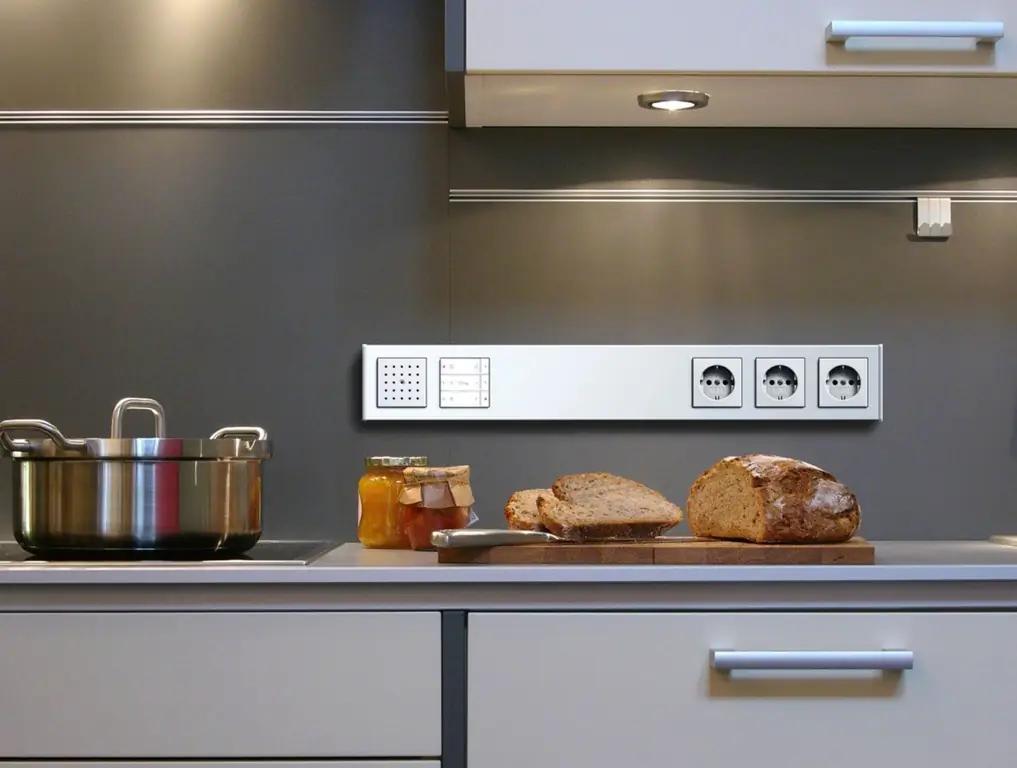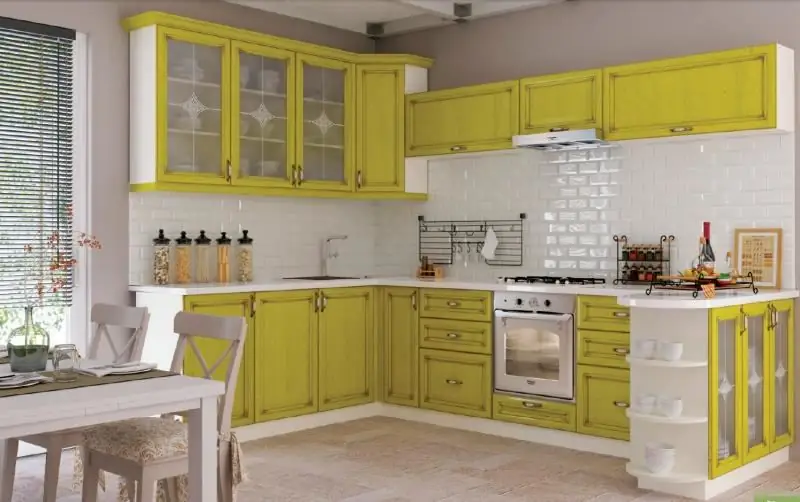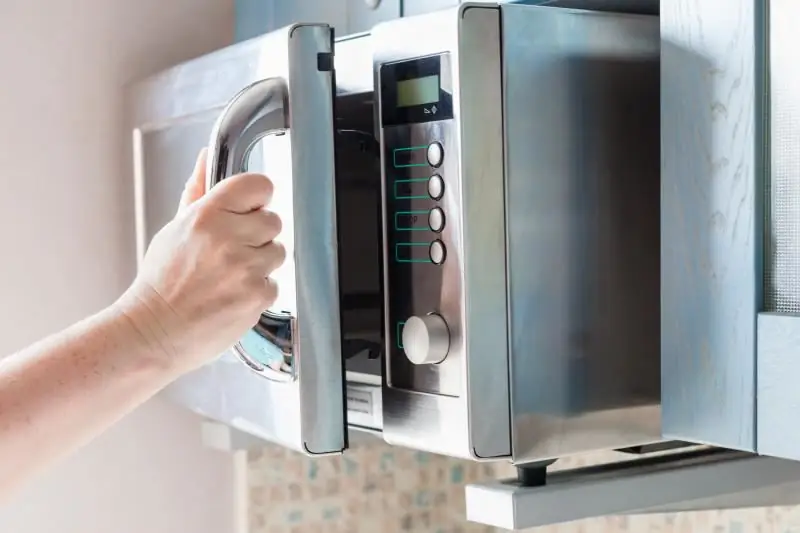
Table of contents:
- Author Bailey Albertson [email protected].
- Public 2023-12-17 12:53.
- Last modified 2025-06-01 07:32.
Spot lighting: how to choose fixtures and lamps to organize the system

Spotlights are often used in the development of design projects for living spaces and kitchens. Such light sources can be mounted on almost any surface, but first it is important to know the features of different types of lamps and the rules for their placement. This will allow you to use spotlights as efficiently as possible to create comfort in different areas of the room.
Content
-
1 The main properties of spotlights
- 1.1 How spotlights work
- 1.2 Visual zoning
- 1.3 Types of spot lighting devices
- 1.4 Benefits
- 1.5 Disadvantages
-
2 How to choose lamps
-
2.1 Selection criteria for lamps and luminaires
2.1.1 Video: features of LED and halogen lamps
-
-
3 Spotlights in the kitchen
-
3.1 How to determine the number of fixtures for the kitchen
3.1.1 Video: an example of calculating the number of luminaires
- 3.2 Distance between luminaires
- 3.3 Ceiling light options
- 3.4 Additional lighting
-
The main properties of spotlights
Point-type luminaires will easily fit into any interior. This is due to the fact that they are compact and presented in different versions. Therefore, it is important to select and position these devices correctly.
How spot lighting works
A spotlight is a small, directional light source. It consists of a base-mounted housing and a replaceable lamp.

Spotlights can be installed on the ceiling or built into furniture
The light flux is conical, and the scattering angle is not more than 30 °. The main stream is directed directly into the area over which the device is installed. Therefore, several such devices are used, since one luminaire is not able to provide sufficient illumination.
Visual zoning
Spot devices allow you to zone the space, visually separating the desired parts of the room from each other. To do this, the lamps are placed where an additional stream of light is needed, for example, above the table, the kitchen working area, or the bar counter. There may be a chandelier in the center of the ceiling. In this way, the spot elements work well with the main lighting fixture.

More luminaires are placed where rich lighting is needed
Such devices are also appropriate for lighting furniture. In this case, they are built into the shelves or cabinet walls. Luminaires are often installed in niches. Such placement options allow not only to zone the space, but also to create a unique interior for any room.
Types of point lighting devices
Different types of luminaires differ not only in appearance, but also in installation technology and dimensions:
-
overhead or external models are most often mounted on frameless bases, for example, brick or concrete walls. The devices are fixed on screws that are screwed into the holes in the housing. The outer part has a diffuser that evenly distributes the light flux;

Surface mounted spotlights Surface mounted luminaires are easy to attach to any surface
-
built-in lamps are mounted on frame bases - furniture partitions, plasterboard structures, niches, panel or rack ceilings. The body of the devices is placed under the base, and outside there is a decorative panel with a diffuser. For recessed luminaires, lamps with a minimum heating level are required, otherwise there is a high risk of damage to the base;

Recessed spot light Recessed luminaires are compact and practical
-
pendant lights are mounted on special ceiling mounts. This creates a free space between the appliance and the base. Many pendant models have a swivel mechanism that allows you to adjust the lighting angle. These luminaires take up more space than built-in or overhead models.

Pendant lamps in the interior of the kitchen Many pendant lights resemble chandeliers
Benefits
Spot lighting has certain features that characterize this method of lighting. The positive features are expressed in the following:
- directed stream of light to the desired area;
- stylish room decoration;
- the ability to control the brightness of lighting;
- compact size of lamps.
disadvantages
The cons of using point devices are also important when planning lighting:
- the complexity of creating a system project;
- for the use of built-in luminaires, it is required to create a plasterboard box, stretch or false ceiling;
- if the device overheats, there is a risk of damage to the base of the ceiling or wall;
- laborious maintenance of the shades is required, associated with the removal of dust from the complex decorative elements of the case.
How to choose lamps
In spotlights, different types of lamps can be used, differing in characteristics, operating features, appearance:
-
incandescent lamps. The device consists of a heat-resistant glass bulb containing a tungsten filament. Such products are inexpensive, presented in different power options and are easily replaced. They become very hot during operation and can damage nearby objects. Therefore, in built-in spotlights, only mirror reflector lamps with a power of no more than 60 W can be used. At the same time, incandescent lamps consume electricity more than other types of sources, and the service life of even high-quality products does not exceed 1,000 hours;

Incandescent reflector lamp Only mirrored incandescent lamps can be used in recessed spotlights.
-
halogen. When using and installing halogen lamps, it is important to install a soft starter. This is due to the fact that "halogens" are very sensitive even to small voltage drops, which reduce their service life. With the correct organization of the system, the luminaires will work for more than 2,000 hours. It is worth considering that the lamps get quite hot, this limits their scope;

Halogen spot lamp Halogen bulbs are smaller and last longer than incandescent bulbs
-
LED. They are very popular for lighting devices, as they consume little electricity, shine brightly, practically do not heat up during operation, and have a service life of several tens of thousands of hours. The range of LED lamps includes waterproof models, products of different wattage, color and shape. The high cost often scares off buyers, but the safety, energy efficiency and reliability of LEDs make up for this disadvantage;

LED lamp LED bulbs feature long lifespan and high energy efficiency
-
luminescent (CFL). They have mercury in their design and therefore are considered insufficiently safe for residential premises. They should be installed and replaced with the utmost care. Overheating of the lamps can damage the stretch ceiling. At the same time, they provide natural light, are compact in size, and consume little electricity.

Spiral fluorescent lamp Fluorescent lamps contain mercury, so you need to handle them as carefully as possible.
The most practical are LED bulbs. Other types of light sources have a lower lifespan, so they have to be changed frequently. This is not always convenient. For example, many lamps are often placed on a stretch ceiling; replacing them is a rather time-consuming process.
Selection criteria for lamps and luminaires
When organizing lighting, the criteria for choosing lamps must be taken into account. The following features are especially important:
- lamps in the same room should be decorated in the same style. A combination of contrasting products is possible, for example: bright and beautifully decorated shades are placed in the center of the ceiling, and laconic devices are located at the edges;
- the characteristics of lamps and luminaires must correspond to the base in which they are mounted;
- installation of a step-down transformer is necessary if low-power devices with a supply voltage of 12 V are used;
- reflective and cooling elements of lamps must be intact, carefully attached to the body;
- recessed luminaires and bulbs for them are best selected before installing the frame base in order to calculate the height of the frame, taking into account the fastening, and also determine the location of the cable;
- for decorative illumination, low-power lamps are enough, and for the main lighting, bright and weakly heating options are needed;
- lamps with a simple design without complicated decor are easy to care for, which should be taken into account when choosing;
- the maximum power of halogen lamps is 35 W for fixed lamps and 40 W for movable, fluorescent lamps - 50 W, incandescent lamps - 50-60 W;
- for stretch ceilings, it is best to use LED and energy-saving lamps, which practically do not heat up.
The manufacturer plays an important role in the choice of lamps. Products of Russian and European companies, such as Philips, Osram, Gauss, Navigator, are presented in many electrical stores and have proven to be the best. From Chinese manufacturers, Canyon, Electrum, ELM, Feron lamps are quite reliable.
Video: features of LED and halogen lamps
Spotlights in the kitchen
Visual zoning of space or simple lighting with spotlights is appropriate in any room. Such appliances are especially convenient in the kitchen, because they can be used to easily separate the working area from the dining area, create practical lighting for cabinets and bring other design ideas to life.
How to determine the number of kitchen lamps
To determine the number of fixtures, you need to know the area of the room. The calculation of the number of devices is carried out taking into account the fact that for each 1 m 2 there should be at least 20 W of lighting power. In the case where point devices are used as decorative lighting, low-power devices up to 20 W can be used.
The number of lamps can be calculated using the formula N = (S * W) / P, where N is the required number of spots (this is how spotlights are called in another way), S is the area of the room in square meters, W is the specific power of the light flux (W / m 2), P is the power of one lamp. For the kitchen, the W value is:
- for incandescent lamps - 12-40 W / m 2;
- for halogen devices - 35 W / m 2;
- for LED luminaires - 3-4 W / m 2.
Video: an example of calculating the number of lamps
Distance between fixtures
When designing a lighting system, an important role is played not only by calculating the number of fixtures, but also determining the distance between them. Leave a gap of at least 20 cm from the corner of the wall to the device. The distance between the spotlights should be 30-40 cm. When installing low-power devices in niches and other bases, the same tolerances should be observed.
Ceiling light options
You can place spotlights on the ceiling in different ways. In any case, you need to take into account the location of devices of different power levels. Basic lighting options:
-
the main source of light is a chandelier in the center of the ceiling, and spotlights are located around. A powerful chandelier provides general illumination, while spotlights complement it and highlight the necessary details. This arrangement of lamps is often used in the kitchen or in large rooms where built-in spots are mounted along the edges of the ceiling;

Chandeliers and spotlights in a large living room In large rooms, spotlights are positioned along the edges of the ceiling to avoid dark areas
-
the brightest light sources are located above the working area, and a small chandelier is located above the dining room. The rest of the seats are illuminated by medium power devices;

Zoning the kitchen-living room with lamps With the help of lamps and chandeliers in different areas of the room, you can organize different levels of illumination
-
spotlights are located only in niches or above the working area. The rest of the space is lit by a chandelier and other lighting fixtures. This is a traditional lighting option in a small kitchen;

Spotlights above the kitchen work area For a small kitchen, one chandelier is enough, and spotlights are used to illuminate the working area
-
lighting only with spotlights. For small narrow rooms, this option allows you to visually expand the space. In addition, this is practically the only way to illuminate a room with low ceilings.

Spotlights in a narrow corridor The use of spot lighting allows you to visually expand the space in a narrow room
When organizing lighting, you should not randomly place lamps, as this will lead to uneven lighting of the space. Therefore, it is best to first highlight the main areas of the room that require bright light. In the remaining areas, low-power devices can be located.
Additional illumination
Spotlights are often used to create an additional lighting system that can be auxiliary to the main chandelier or decorative. In this case, spots can be placed in several ways:
-
above the cabinets. For this, a panel is mounted on top, on which the lamps are attached. Both built-in and overhead models are suitable here;

Lighting over kitchen cabinets The lighting above the cabinets can be made with both built-in and pendant lights
-
inside cabinets or drawers - a convenient and practical solution for arranging a kitchen set. For this, compact devices are chosen, and holes are created in the walls of the furniture, the size of which corresponds to the dimensions of the lamp body;

Lighting drawers in the kitchen Lighting in drawers makes furniture easy to use
-
on walls to illuminate paintings, decorative niches, panels or mirrors.

Highlighting pictures Spotlights can be used for additional illumination of paintings in the twilight
Spotlights go well not only with chandeliers, but also with LED strips. This allows you to create an individual lighting project using discrete and distributed light sources.
The selection and installation of spotlights can be done independently, but it is important to take into account the location, type of lamps and the power of the devices. Thanks to this, the lighting system will be safe and comfortable.
Recommended:
The Location Of The Sockets In The Kitchen: Placement Height, How Many And Where Needed, Photos, Diagrams

Rules and regulations for the location of outlets in the kitchen. Calculation of the required number of outlets. Drawing up an electrical wiring diagram. Types and installation of sockets
Porcelain Stoneware Or Ceramic Tiles For The Floor In The Kitchen - Which Is Better, Comparative Characteristics, Expert Recommendations, Photo

Comparison of porcelain stoneware and ceramic tiles by the main parameters. Recommendations from experts on the choice of material for laying on the floor in the kitchen
Kitchen With Patina On The Kitchen Set And Furniture: What It Is, Interior Design Features, Photo

What is patina. Advantages and disadvantages of patination. Kitchen design with patina: colors, styles and interior features
American Shorthair Cat: Description Of The Breed, Characteristics Of Character And Behavior, Rules Of Care And Feeding Of Cats, Photo

The history of the origin of the American shorthair cat, appearance and character. Choosing a kitten. Animal care rules. Health and nutrition. Breeding
Where To Put The Microwave In The Kitchen: Placement Options In A Small And Large Space, Photo

Microwave placement rules, where you can and where you can't. Location options in the kitchen, pros and cons of each. How to hang the microwave yourself
